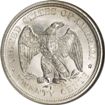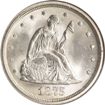Twenty Cent Pieces
A short lived denomination.


The origin of the twenty cent piece began as early as 1791. Legislation was proposed to congress and it was to be named the "double disme". However, Congress declined the idea because the denomination was too similar to the quarter and would only lead to confusion. The idea was brought to Congress again in 1806 only to be declined again.
In 1874, nearly 70 years later, Sen. John Percival introduced a bill for the third time to authorize coinage of the twenty-cent piece. This time he expressed the need for the denomination due to the lack of minor coins in circulation. President Ulysses S Grant signed the bill into law on March 3, 1875.
Most places of business were charging ten to fifteen cents apiece for items. Most people paid with quarters and expected to be shortchanged in this situation. Storekeepers were capitalizing on the lack of small change at that time.
These silver coins were very short-lived for obvious reasons and were only produced from 1875 to 1878. Today, some individual coin collectors enjoy this denomination and collect it for specific dates and mintmarks. However, most prefer a good example for a types set.
Coin Specifications:
Diameter: 22mm
Composition:
90% silver, 10% copper
Weight: 5.00 grams
Edge: Plain


